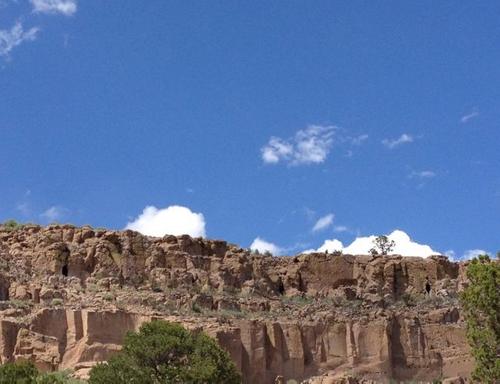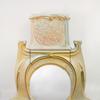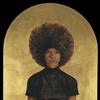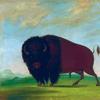New Mexico, July 13 and 14
- July 25, 2015 12:43

Sunday, July 12, was the last day of Art Santa Fe 2015. We loved being there and had many wonderful visitors. We were especially pleased that works by Peggy Bacon, William Baziotes, Isabel Bishop, Howard Daum, Peter Grippe, Hugh Mesibov, and Angelo Pinto, (east-coasters all) were noticed and admired!
Monday, July 13, we drove to the Puye Cliff Dwellings, a National Historic Landmark and ancestral home of todays’ Santa Clara Pueblo Native Americans. The site is run by the Pueblo; the guides are members as well. The mesa is volcanic tuff, a light, easily cut material that was also used to filter water for drinking. The hollowed out cave homes at the side of the steep cliff were used in winter as the stone held the heat of the sun through the night. At the top of the mesa there were window-less homes, one, two, or even three stories, that were entered by climbing a ladder one flight up and then down into the rooms, each about nine by nine feet. These long skinny “town homes” with neighbors on either side were built of the volcanic tuff and occupied by extended families. From about 900 AD to 1580, when there was a severe draught, as many as 1500 people lived there at a time. They communicated with other mesas through runners, but in emergencies used color-coded smoke signals as well. The cliffs were clearly defensive housing. The hand and footholds on the face of the cliff were strategic: life-savers if you knew the correct pattern or route -- a death trap if you didn’t.
On Tuesday, July 14, we walked two trails at the Petroglyph National Monument, Albuquerque, NM. There are more than 20,000 prehistoric and historic Native American and Hispanic petroglyphs (images carved into rock) and pictographs (images painted onto the rock) in a park with a huge variety of trails. The basalt boulders along Albuquerque’s West Mesa, were formed by volcanic eruptions as long as 150,000 years ago. They are dark brown close up but black from a distance; their surfaces range from grainy or pitted to smoothly iridescent. Thanks to a rainy spring and frequent thunderstorms there were green plants among the giant boulders – much more greenery than we expected.




__2270x400_c.jpg)















